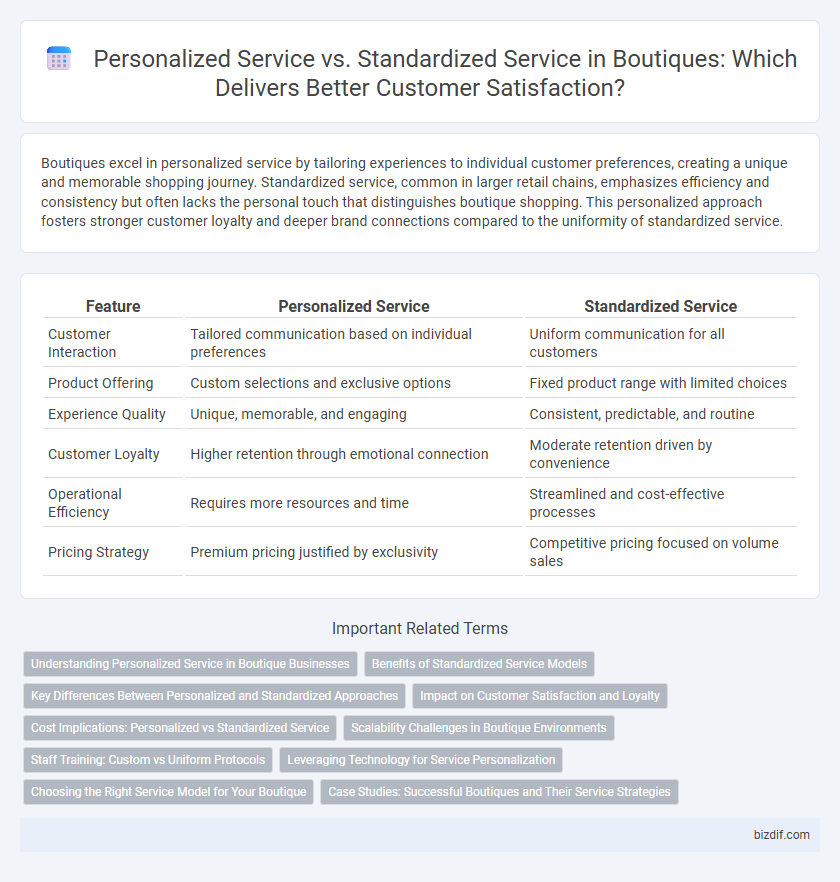Boutiques excel in personalized service by tailoring experiences to individual customer preferences, creating a unique and memorable shopping journey. Standardized service, common in larger retail chains, emphasizes efficiency and consistency but often lacks the personal touch that distinguishes boutique shopping. This personalized approach fosters stronger customer loyalty and deeper brand connections compared to the uniformity of standardized service.
Table of Comparison
| Feature | Personalized Service | Standardized Service |
|---|---|---|
| Customer Interaction | Tailored communication based on individual preferences | Uniform communication for all customers |
| Product Offering | Custom selections and exclusive options | Fixed product range with limited choices |
| Experience Quality | Unique, memorable, and engaging | Consistent, predictable, and routine |
| Customer Loyalty | Higher retention through emotional connection | Moderate retention driven by convenience |
| Operational Efficiency | Requires more resources and time | Streamlined and cost-effective processes |
| Pricing Strategy | Premium pricing justified by exclusivity | Competitive pricing focused on volume sales |
Understanding Personalized Service in Boutique Businesses
Personalized service in boutique businesses tailors customer interactions based on individual preferences, purchase history, and unique needs, creating a distinct shopping experience. This approach contrasts with standardized service, which relies on uniform procedures and generalized customer engagement across all clients. Deep understanding of personalized service enables boutiques to build strong customer loyalty, enhance satisfaction, and differentiate themselves in competitive retail markets.
Benefits of Standardized Service Models
Standardized service models in boutiques ensure consistent customer experiences by streamlining operations and reducing errors. These models enhance efficiency, allowing staff to focus on core tasks and maintain high-quality service levels across all transactions. Consistency in service also builds customer trust and simplifies training, leading to improved scalability and profitability.
Key Differences Between Personalized and Standardized Approaches
Personalized service in boutiques revolves around tailoring customer experiences through individualized attention, unique product recommendations, and customized solutions that foster loyalty and satisfaction. Standardized service, on the other hand, employs uniform procedures and consistent offerings designed to streamline operations and ensure predictability across all customer interactions. Key differences include flexibility in addressing specific customer needs for personalized service versus efficiency and scalability achieved by standardized approaches.
Impact on Customer Satisfaction and Loyalty
Personalized service in boutiques enhances customer satisfaction by tailoring experiences to individual preferences, resulting in increased loyalty and repeat business. Standardized service, while efficient, often lacks the emotional connection that fosters long-term customer relationships. Investing in personalized interactions drives higher customer retention and boosts brand reputation through positive word-of-mouth.
Cost Implications: Personalized vs Standardized Service
Personalized service in boutiques often incurs higher costs due to tailored customer interactions, specialized training, and increased time per client, impacting overall pricing. Standardized service reduces expenses through streamlined processes, uniform training, and quicker customer turnover, allowing for more competitive pricing structures. Balancing personalized experiences with cost efficiency is crucial for boutique profitability and customer satisfaction.
Scalability Challenges in Boutique Environments
Boutique environments prioritize personalized service, which fosters strong customer loyalty but presents significant scalability challenges due to the intensive labor and time required per client. Standardized service models streamline operations and improve efficiency but often compromise the bespoke experience that defines boutique brands. Balancing these approaches requires innovative strategies like technology integration and staff specialization to maintain quality while scaling growth.
Staff Training: Custom vs Uniform Protocols
Boutique staff training emphasizes personalized service through tailored protocols, enabling employees to adapt to individual customer preferences and deliver unique experiences. In contrast, standardized service in larger retail relies on uniform training procedures to ensure consistency and efficiency across all locations. Custom training programs foster stronger customer relationships by empowering staff with situational judgment rather than rigid adherence to generic scripts.
Leveraging Technology for Service Personalization
Boutiques leveraging technology for service personalization utilize advanced data analytics and AI-driven customer insights to tailor offerings uniquely to individual preferences, enhancing customer satisfaction and loyalty. Unlike standardized service models, personalized service in boutiques integrates CRM systems, mobile apps, and virtual fitting tools to deliver customized experiences at scale. This technology-driven approach allows boutiques to anticipate customer needs, recommend products effectively, and create a seamless, engaging shopping environment that distinguishes them from broader retail competitors.
Choosing the Right Service Model for Your Boutique
Selecting the appropriate service model for your boutique hinges on understanding your target clientele's expectations for either personalized or standardized service. Personalized service enhances customer loyalty and satisfaction by offering tailored experiences, which is essential for luxury or niche boutiques seeking differentiation. Standardized service streamlines operations and ensures consistency, ideal for boutiques with high volume and emphasis on efficiency.
Case Studies: Successful Boutiques and Their Service Strategies
Case studies reveal that successful boutiques implementing personalized service strategies achieve higher customer loyalty and increased repeat sales compared to those using standardized service models. Brands like Hermes and Glossier leverage tailored consultations and bespoke recommendations, enhancing customer satisfaction and fostering strong brand affinity. Research indicates boutiques with personalized service often report up to 30% greater customer retention rates than industry averages reliant on uniform service approaches.
Personalized Service vs Standardized Service Infographic

 bizdif.com
bizdif.com